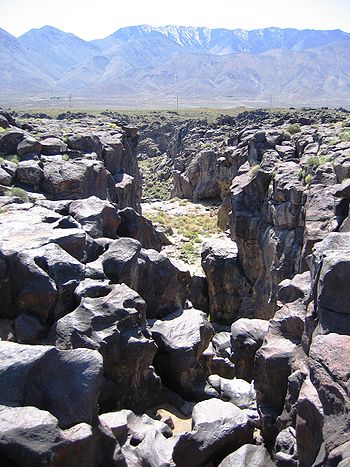
Fossil Falls
During the last ice age, glaciers formed in the Sierra Nevada.
Meltwater from the glaciers pooled into large lakes, including
Owens Lake and the Owens River. The river traveled through Indian
Wells Valley, and its course was diverted several times by volcanic
activity. The falls were formed when the river was forced to divert
its course over a basalt flow, polishing and reshaping the rock
into a variety of unique shapes and forms.
All the lava flows at Fossil Falls are basaltic. The Coso
volcanic field brought flows from the north east and later Red
Hill, which can be viewed from Fossil Falls, released the younger
lava. The flows occurred between 400,000 years ago and 10,000 years
ago. During this period, the glacial flows would run through Fossil
Falls and smooth the vesicular basalt. The erosion found at Fossil
Falls was formed by the youngest glacial runoff, called the Tioga,
from the Sierra Nevada Mountain Range about 20,000 to 10,000 years
ago.
In addition to the small gas vesicles in the basalt, there are
large, perfectly circular penetrations in the basalt. These are
erosional features called potholes. It is speculated that Red Hill
cast out granitic detritus which fell into Fossil Falls. Water
accelerates as it moves past the rocks. The relatively still water
ahead forced the moving water to slow down and rotate to form an
eddy. The high velocity currents were enough to catch the granitic
rocks from Red Hill and spiral them downwards in multiple vortices,
drilling them into the basalt. Sediments would get trapped and
continue to circularly erode the holes.
Fossil Falls originally started downstream from where it sits
today; it moved upstream as waterfalls typically do. Water falling
over the edge of the waterfall undercut the falls and caused them
to move upstream and grow taller. This process is called
plunge-pool erosion.
To log this cache, please email me the answers to these
questions below as well as upload a picture of yourself displaying
your GPSr (please do not give away answers in your
photo).
Question 1: According to the Interpretive sign, How were Fossil
Falls sculpted?
Question2: According to the Interpretive sign, How tall are Fossil
Falls?

Find more Earthcaches